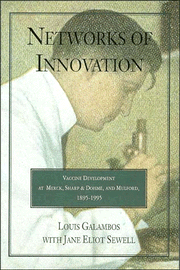Book contents
- Frontmatter
- Contents
- PREFACE
- 1 1894: “The foremost medical question of the day”
- 2 The Mulford Story
- 3 A Sharp & Dohme Interlude
- 4 The Virology Network and a New Program at Merck Sharp & Dohme
- 5 Hilleman's Innovations: First Phase
- 6 Dangerous Interlude
- 7 Transforming Bacteriology: A Second Phase
- 8 New Networks, New Leadership: The Hepatitis B Vaccines
- 9 Vaccine Innovation in the Nineties: New Strategies, New Opportunities, and Public Confrontations
- 10 Historical Perspectives on the Process of Innovation
- ACKNOWLEDGMENTS
- A WORD ABOUT SOURCES
- INDEX
- Plate section
1 - 1894: “The foremost medical question of the day”
Published online by Cambridge University Press: 06 July 2010
- Frontmatter
- Contents
- PREFACE
- 1 1894: “The foremost medical question of the day”
- 2 The Mulford Story
- 3 A Sharp & Dohme Interlude
- 4 The Virology Network and a New Program at Merck Sharp & Dohme
- 5 Hilleman's Innovations: First Phase
- 6 Dangerous Interlude
- 7 Transforming Bacteriology: A Second Phase
- 8 New Networks, New Leadership: The Hepatitis B Vaccines
- 9 Vaccine Innovation in the Nineties: New Strategies, New Opportunities, and Public Confrontations
- 10 Historical Perspectives on the Process of Innovation
- ACKNOWLEDGMENTS
- A WORD ABOUT SOURCES
- INDEX
- Plate section
Summary
IN 1894, many Americans were deeply concerned about labor violence, about an economy sliding into the worst depression the country had ever experienced, and about the adverse impact mass immigration seemed to be having on urban life. To many middle-class Americans, the new immigrants from southern Europe were especially troublesome. Crowded into slums, living in tenements, the immigrants were associated by the “better” class of citizens with corrupt ward-level politics, with a breakdown in the country's traditional values, and with urban diseases.
While there was no justification for a moralistic allocation of blame for disease, there was abundant justification for the concerns of the urban middle class. Mortality rates were high for several infectious diseases and the living conditions among recent immigrants in the cities contributed to the incidence of tuberculosis, pneumonia, and diphtheria, three of the leading causes of death in the United States. Physicians had not been able to provide effective therapies for these or other infectious diseases and the morbidity rates were appalling.
Concern about these health-related aspects of what was often called “The Social Problem” had led to a significant public health movement in this country. In the largest cities, municipal health agencies had struggled for many years to deal with problems of sanitation and sickness. In New York City, a Metropolitan Board of Health had been active since 1866, and after the bacteriological basis of infection began to be understood, the New York Board had established a new Division of Pathology, Bacteriology, and Disinfection to conduct scientific research on infectious diseases. Other cities were launching similar efforts, and during the 1890s, a network of innovative public institutions began to take shape.
- Type
- Chapter
- Information
- Networks of InnovationVaccine Development at Merck, Sharp and Dohme, and Mulford, 1895–1995, pp. 1 - 8Publisher: Cambridge University PressPrint publication year: 1996



